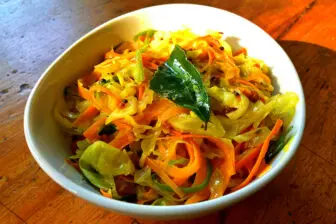As with many others, I suspect my first extended foray into Indian food was in New York City on Curry Row — East Sixth Street between Second and Third avenues in the East Village. This densely packed monoculture of colorful restaurants curried favor with adventurous and budget-minded diners looking for a lot of spice. Dishes like vindaloo, tandoori and tikka masala were a foreign language to most Westerners.
By now we’ve accepted many of the general forms of this rich tradition without appreciating the depth and sophistication of a rich culinary culture. Which is why I paid attention when a discerning friend accosted me in the parking lot at Foodtown (aka town square). He insisted I had to try a new Indian restaurant, Gymkhana, in the Westage Mall on Route 9 in Fishkill; I drafted my buffet-special-loving pal, John, to keep me honest.
The restaurant was freshly remodeled, but the real treat came in rolling back the lids of each of the dozen buffet servers. This was not “typical” Indian food — we left sated and pleasantly surprised.
A follow-up trip to sample the à la carte menu confirmed my impression: Jingha bagari was an incredible appetizer of grilled, lightly charred shrimp in a sweet(ish) and spicy red sauce chunky with finely chopped tomatoes, green peppers and herbs.
For entrees, Gymkhana’s take on gustaba (a Kashmiri specialty) is a marinated tandoor-grilled, cardamom-and-mace infused rack of New Zealand lamb served with seared mixed vegetables of the sauce or glaze. Amma’s Fish Curry is made Kerala-style: chunks of fish simmered in a coconut milk, turmeric, ginger and green mango curry. Navratan (“Nine Gems”) Korma is a mildly spiced almond and cashew-creamed curry of mixed vegetables and paneer that was a perfect foil for the spicy lamb and sublime fish curry.
The house manager, Viljo Varghese, and chefs Sanu Pathrose and Linto Devassykutty were schoolmates in the southwestern Indian coastal province of Kerala, and each graduated from the Indian Culinary Institute. Gymkhana is their first collective effort.
Their poriyal recipe, shared here, is a traditional stir-fried vegetable slaw of cabbage and carrots. It is seasonably flexible, suggesting you stay close to the brassica family (broccoli or cauliflower) or other root vegetables (beets and the like). Green beans or okra would be welcomed, and sliced onions are sometimes used. Gymkhana adds sliced mushrooms; a traditional finish is a couple of tablespoons of grated coconut.
Its real secret, as with most Indian cooking, is spicing and technique. Here mustard seeds, whole cumin seeds, a slight tablespoon each of chana dal (small split chickpeas) and white urad dal (white lentils) are sauteed, first to toast them, but primarily to infuse the oil, creating a tadka or chaunk (seasoned oil), the name given to the technique.
Green vegetal herbs — curry leaves and green Indian chiles — are briefly sauteed in the tadka to further infuse it before stir-frying the vegetables. A pinch of asafoetida (aka hing), the grated dried gum of a specific variety of genus ferula, is added late. It’s a super-specific Indian spice and pungent in its raw state (with colloquial names such as the appealing “vegetable truffle” or the frightening “merde du diable”), and a pinch is all that is required. The strong odor dissipates during cooking, contributing a soft onion flavor. Think of it as a spice odyssey.
Cabbage & Carrot Poriyal

Restaurant Gymkhana; Serves 4 to 6 as a side
- 3 cups green cabbage (about ½ medium head), shredded
- 1 medium carrot, grated
- 1 teaspoon whole cumin seeds
- ½ teaspoon yellow mustard seeds
- 8 fresh curry leaves*
- 2 green Indian chile peppers, slit* (substitute 1 jalapeño or ½ serrano)
- ½ teaspoon ground turmeric
- 1 teaspoon black pepper
- 1 teaspoon white urad dal*
- 1 teaspoon chana dal*
- 1 pinch asafoetida (hing)*
- 3 to 4 tablespoons coconut oil
- Salt, to taste
1. Heat oil in a heavy-bottomed pan or wok. Add mustard seeds and cumin seeds. Once they start to sputter, add urad dal and chana dal and sauté, tossing until golden and fragrant.
2. Add curry leaves, chili and hing; sauté for a minute. Add cabbage, a good sprinkle of salt and sauté for 5 to 10 minutes until cooked.
3. Add 2 to 3 tablespoons water and turmeric; stir to combine. Add carrot and mix well; check salt and pepper to taste, cooking until carrot is just done. Remove from heat and serve hot. Rice is the traditional accompaniment.
* Cumin and mustard seeds are readily available but the specific Indian spices and chile (and particularly fresh curry leaves) are harder to come by. Saraswati, at 1299 Route 9 in Wappingers Falls, is a good local source.

